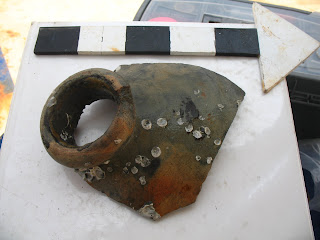Field school summary: By Mark Vadas
The 2010 session was a very exciting summer for the UWF Maritime Archaeology Field School program. The first week was spent training the students to set up and use all of the specialized field equipment. The students also learned search and excavation methods, such as using the dredge and how to perform circle searches.
The first half of field school was spent mostly working on the EPII and B-Street Schooner. The students started dredging out the stern units and worked on the ballast piles. Many interesting artifacts were discovered after the dredging of EPII including a brass pin, a wooden comb, an intact olive jar fragment, as well as a second gudgeon that was uncovered adjacent to the one that had been uncovered the previous year. On the B-Street Schooner, the stern section of the ship revealed pine timbers and other artifacts along with an extensive amount of the hull. Along with these sites in Escambia Bay, some students had the opportunity to go to Mobile Bay to look for lost torpedo doors of the U.S.S. Drum; large sheets of metal were discovered which could possibly be the lost doors of the submarine.
During the second half of field school, only a few days were spent in Pensacola Bay before the worst-case scenario became real and oil from the Deepwater Horizon spill entered the bay and all field school activities were moved to the Blackwater River. At Shield's Point on the river, some of the early twentieth-century shipwrecks were mapped. After some of the work at these sites was completed, crews moved farther up the river to the Swing Bridge and Center Board Schooner sites near downtown Milton. Measurements were recorded and artifacts were mapped for both of these sites. With these measurements, students were able to get a good site plan for both of the wrecks. On the second to last day of field school, a new wreck was discovered near some heavy machinery that was left along the shore.
Field School provided a tremendous opportunity to survey a large section of the Blackwater River using side scan sonar and the magnetometer. Using these techniques, a sunken barge was discovered right off of the boat ramp that had been used to launch the boats for the survey work. It was an exciting end to a summer of gaining more knowledge and learning new skills that will serve us well as we pursue our careers in archaeology. In the end, rather than being a backup plan, the Blackwater River turned into a goldmine of archaeological experience. Instead of simply working on a handful of wrecks in the bay, students got an opportunity to work on over a dozen different wrecks which provided a myriad of different construction types and environmental challenges to overcome, but they adapted brilliantly. Hopefully future students will have an opportunity to return here, and the Blackwater will become as big a part of Field School as EP II, B-Street, and Seminole.
 |
| (Jake Shidner, Peter Sittig, Amanda Dahlberg, Hallie Johnson, Morgan Wampler, and Mark Vadas on the Blackwater.) |












